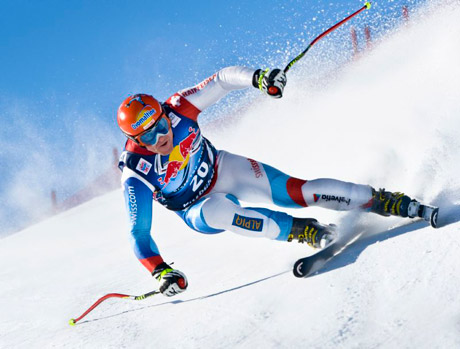ALPINE SKI. The combined scoring of the downhill and slalom Alpine events in the form of the Alpine Combination was originally introduced to determine the best ski racers, as opposed to the Nordic Combination of ski jumping and cross country. It was in this form that the first Arlberg Kandahar Races took place in 1928, the first Lauberhorn-Races in Wengen, Switzerland in 1930 and the first Hahnenkamm-Races in 1931. Since then, adjustments have been made in both the individual downhill and slalom events as well as the Alpine combined.

Hahnenkamm 2012, Didier Cuche (SUI), 1st in Downhill Training 2. Photo credit: Rolex / Kurt Arrigo
During the FIS-Congress in Korea in spring and FIS autumn meetings in Zurich, the key issue of Super Combination or Super G was of particular interest to Kitzbühel. During these initial talks, the Austrian Ski Federation and Kitzbühel Ski Club emphasised the fact that the Super-G enjoys special interest and has, therefore, a correspondingly high sporting value. This new combination is of great importance to the International Ski Federation, as at least two World Cup events have to have taken place in order for this combination to remain in the Olympic Games and World Championships. FIS highly recommends that these take place in the classic venues of Wengen and Kitzbühel.
During the FIS autumn meetings, a proposal for compromise was called for during a meeting of the World Cup subcommittee: From 2014 onwards, the Super-G would continue to count as a World Cup discipline in Kitzbühel, however, an additional combined event should be permitted. In this case, a slalom event for combination rankings would follow late afternoon of the same day, under floodlit conditions. This proposal was well received and remains in the hands of the FIS Council for further perusal.
„Back to the Roots“
This anticipated compromise means that there will continue to be an annual „Hahnenkamm Winner“ in the Alpine Combination in Kitzbühel who will benefit from winning World Cup points. The Champion’s Honour Roll, established in 1931, could therefore be continued.
One advantage is that the equal opportunity for Downhill and Super-G specialists will be adapted to the modern requirements of this sport. In any case, tighter decisions and more drama can be expected. The combined slalom will start in the reverse order of the Super-G, not according to slalom world cup points. This corresponds with original combination regulations, hence „back to the roots“.
Friday will be a new highlight for spectators with two programme focuses. The world elite will be at the starting line for this special Super-G on Friday to test their prowess in one of the most technically challenging Super-G races and the best combination athletes will compete in the combined slalom in the evening. The special slalom on Sunday will also be enhanced, as only the very best will be exclusively at the starting line.
The Kitzbühel Ski Club, Organizers of the Hahnenkamm Races, thanks the Austrian Ski Federation and International Ski Federation for this proposal in the interests of the athletes as well as ski sport fans. With that, a new sporting era at the Hahnenkamm can begin.
Hahnenkamm Rennen
www.hahnenkamm.com
10.10.2012

| 

